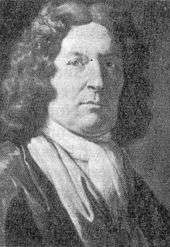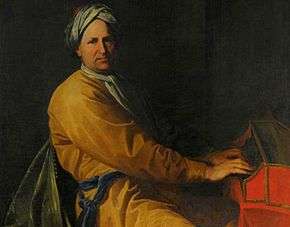Bernardo Pasquini
Bernardo Pasquini (Massa e Cozzile, 7 December 1637 – Rome, 21 November 1710) was an Italian composer of operas, oratorios, cantatas and keyboard music. A renowned virtuoso keyboard player in his day, he was one of the most important Italian composers for harpsichord between Girolamo Frescobaldi and Domenico Scarlatti, having also made substantial contributions to the opera and oratorio.

Biography

Pasquini was born in Massa in Val di Nievole (today Massa e Cozzile, in the province of Pistoia, Tuscany). He was a pupil of Mariotto Bocciantini in Uzzano (Pistoia). Around 1650 he moved to Ferrara with his uncle Giovanni Pasquini. Here in 1653–55 he was organist of Accademia della Morte.
Later he moved to Rome and in 1657 became organist of Santa Maria in Vallicella (Chiesa nuova). In February 1664 he was appointed organist of the Basilica di Santa Maria Maggiore and Santa Maria in Aracoeli. In November 1667 entered to the service of Prince Giovanni Battista Borghese, and from May 1693 of Prince Marcantonio Borghese, son of the latter.[1]
As a composer and keyboard player, he collaborated to the music performances patronised by most famous patrons in Rome, such as cardinals Flavio Chigi, Benedetto Pamphilj, Pietro Ottoboni, and Queen Christina of Sweden in whose honour his operas L'Alcasta (libretto by Giovanni Filippo Apolloni), and Il Lisimaco (libretto by Giacomo Sinibaldi) were performed respectively in 1673 and 1681.[2]
Together with Arcangelo Corelli and Alessandro Scarlatti, in 1706 Pasquini became member of the Academy of Arcadia.
He composed numerous operas, all staged in Rome between 1672 and 1692, and partially replayed in several Italian theatres (Florence, Pisa, Naples, Ferrara, Perugia, Genoa, Rimini etc.).
He was also an renowned teacher of harpsichord. Among his pupils Tommaso Bernardo Gaffi and his nephew Felice Bernardo Ricordati. Among the most important musicians who had lessons from him, Georg Muffat, Johann Philipp Krieger, Giuseppe Fabbrini, Floriano Arresti, Johann Georg Christian Störl, and Franz Jakob Horneck, and probably also Ferdinand Tobias Richter and Carlo Domenico Draghi.[3]
Pasquini died in Rome on 21 November 1710, and was buried in his parish church of San Lorenzo in Lucina. A sepulchral monument, still existing in the church, was erected by the nephew Felice Bernardo Ricordati and the pupil Tommaso Bernardo Gaffi.
His keyboard music is almost entirely preserved in four manuscript volumes (partially autographs), which were compiled between circa 1691 and 1708, by the composer and other collaborators, now preserved in Berlin (Staats Bibliothek – Preußische Kulturbesitz, Landsberg 215), and London (British Library, Add. 31501/I-II-III).
One of his harpsichord pieces was transcribed for orchestra by Ottorino Respighi for his suite Gli uccelli.[4]
Works
Operas
- La sincerità con la sincerità ovvero il Tirinto (1672)
- L'amor per vendetta ovvero l'Alcasta (1673)
- La donna ancora è fedele (1676)
- Trespolo tutore (1677)
- La forza d'amore (before 1679)
- Dov'è amore è pietà (Ipermestra) (1679)
- Idalma ovvero chi la dura la vince (1680)
- Il Sidonio ovvero il raro esempio di costanza e fede (1680)
- Il Lisimaco (1681)
- La Tessalonica (1683)
- Arianna (1685)
- Il silentio d'Arpocrate (1686)
- Santa Dimna figlia del re d'Irlanda (1687; only act 2. Act 1 Alessandro Melani; Act 3 Alessandro Scarlatti)
- I giochi troiani (1688)
- La caduta del regno delle Amazzoni (1690)
- Alessio (1690)
- Il Colombo overo l'India scoperta (1690)
- Eudossia (1692)
Oratorios
- Caino e Abele (1671)
- Agar (1675)
- Assuero (1675)
- Sant'Alessio (1675)
- Divae Clarae triumphus (1682)
- L'idolatria di Salomone (1686)
- I fatti di Mosè nel deserto (1687)
- Il martirio dei santi Vito, Modesto e Crescenzia (1687)
- La purità trionfante overo Martiniano il santo (1688 in collaboration with G.L. Lulier, T.B. Gaffi, G. Ercole, L. Amadori)
- La sete di Cristo (1689)
- La caduta di Salomone (1693)
- Davide trionfante contro Goliath (1694)
- S. Maria di Soria (1694)
- S. Filippo Neri (cantata)
Pasquini composed around sixty cantatas, mainly for one voice and continuo, but also for two or three voices, with or without instruments, and continuo.[5]
He celebrated the ubiquitous cuckoo in Toccata con lo Scherzo del Cucco, written in florid style in 1702. It is perhaps the best keyboard cuckoo piece in existence for it imitates the cuckoo's notes, which seems to have been a favourite device in early baroque music.
Selected recordings
- Mottetti a voce sola e composizioni per organo, Alea Musica, Alexandra Nigito. Tactus (TC.631802)
- Oratorio Caino e Abele, conductor Alessandro De Marchi. Symphonia 1990
- Oratorio Santa Agnese Consortium Carissimi. 2 CD Arion
- 2 passion cantatas – Hor ch'il Ciel fra densi horrori; Padre, Signore e Dio. Sharon Rostorf-Zamir, Furio Zanasi, Capella Tiberina, conductor Giovanni Caruso. Brilliant Classics, DDD, 2010
- Bernardo Pasquini – Suites and Variations, Lydia Maria Blank, harpsichord, 2015, Etcetera (KTC 1532)
- La sete di Christo, oratorio, Concerto romano, conductor Alessandro Quarta, 2015, Christophorus 77398
- Pasquini: Sonate Per Gravecembalo, Manuscript S.B.P.K. Landsberg 215, Roberto Loreggian. Brilliant Classics, 2019.
- Pasquini: Sonate per Gravicembalo, Roberto Loreggian. Chandos, 2004 (CHAN 0704).
Notes
- A. Morelli, La virtù in corte. Bernardo Pasquini (1637-1710), Lucca, 2016, pp. 86-89.
- C. Sartori, I libretti italiani a stampa dalle origini al 1800, Cuneo, 1990–1994, #1439, 14299
- A. Morelli, La virtù in corte. Bernardo Pasquini (1637-1710), Lucca, 2016, pp. 97-98, 333.
- Glennon, James (1980). Understanding Music. St. Martin's Press. p. 214. ISBN 978-0-312-83144-8.
- Complete modern edition Bernardo Pasquini, Le cantate, ed. by Alexandra Nigito, Turnhout, 2012.
References
- Morelli, Arnaldo (2007). "Pasquini, Bernardo". Die Musik in Geschichte und Gegenwart – Personenteil. 13 (2nd ed.). Kassel. pp. 168–171.
- Arnaldo Morelli, La virtù in corte. Bernardo Pasquini (1637–1710), Lucca, Libreria Musicale Italiana, 2016.
External links
| Wikimedia Commons has media related to Bernardo Pasquini. |